Quanta Computer ZI2WM3B2100BT Notebook With WLAN and Bluetooth Modem User Manual TM660
Quanta Computer Inc Notebook With WLAN and Bluetooth Modem TM660
Contents
- 1. User Manual 1 of 2
- 2. User Manual 2 of 2
User Manual 2 of 2
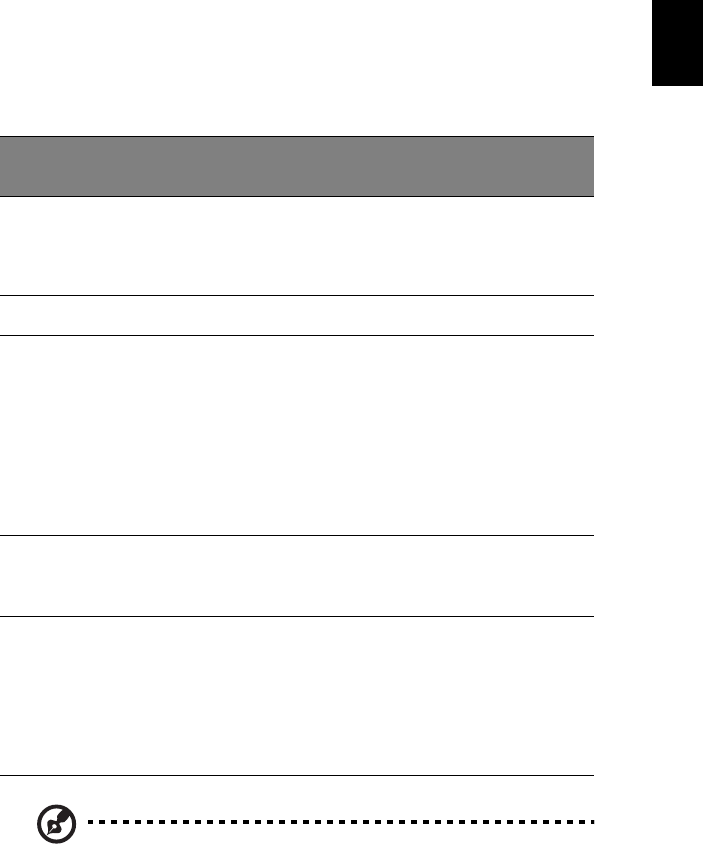
23
English
Tapping on the touchpad produces similar results.
•Use the 4-way scroll (2) button (top/bottom/left and right) to scroll
a page up, down, left or right. This button mimics your cursor
pressing on the vertical and horizontal scroll bars of Windows
applications.
Note: Keep your fingers dry and clean when using the touchpad.
Also keep the touchpad dry and clean. The touchpad is sensitive to
finger movements. Hence, the lighter the touch, the better the
response. Tapping harder will not increase the touchpad’s
responsiveness.
Function Left button Right
button
Center
buttons Tap
Execute Click twice
quickly Tap twice (at the
same speed as
double-clicking a
mouse button)
Select Click once Tap once
Drag Click and
hold, then
use finger to
drag the
cursor on the
touchpad
Tap twice (at the
same speed as
double-clicking a
mouse button)
then hold finger
to the touchpad
on the second tap
and drag the
cursor
Access
context
menu
Click
once
Scroll Click and
hold the
button in
the desired
direction
(up/down/
left/right)

1 Getting to know your TravelMate24
English
Storage
This computer supplies you with the following media storage:
•High-capacity Enhanced-IDE hard disk
•AcerMedia drive
Hard disk
The high-capacity hard disk is the answer to your storage needs. This is
where your programs and data are stored.
AcerMedia bay
The AcerMedia bay accepts a wide variety of optional media drive
modules for use with your computer. These optional items include:
•CD-ROM drive
•DVD-ROM drive
•DVD/CD-RW drive
•Second hard disk drive
•Second battery
Note: To swap AcerMedia drive modules, see “Swapping
AcerMedia drive modules” on page 52
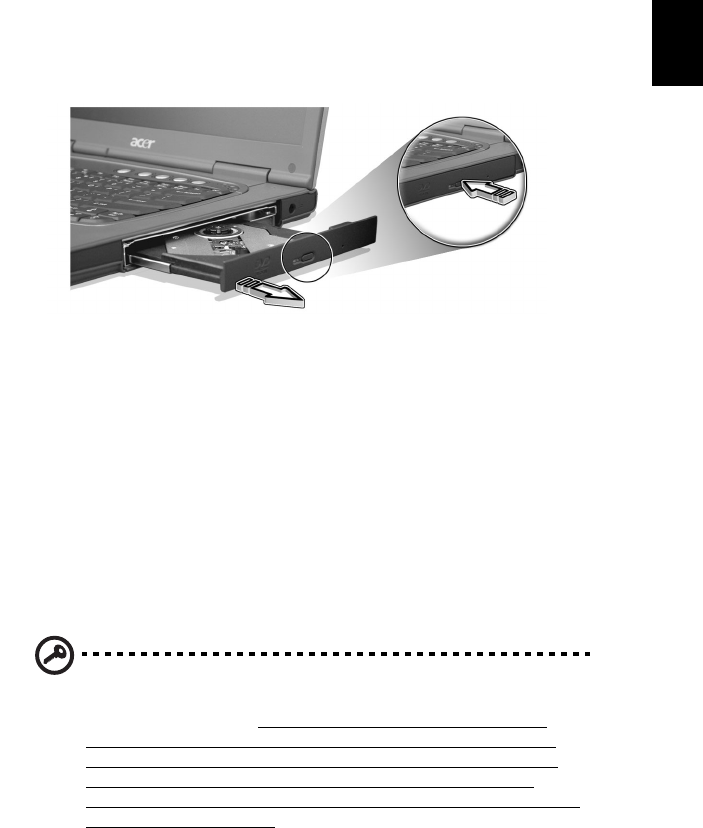
25
English
Ejecting the optical (CD or DVD) drive tray
To eject the optical drive tray when the computer is turned on, press
the drive eject button.
When the power is off, you can eject the drive tray using the
emergency eject hole. See page 58.
Using software
Playing DVD movies
When the DVD-ROM drive module is installed in the AcerMedia bay,
you can play DVD movies on your computer.
1 Eject the DVD tray and insert a DVD movie disc; then close the DVD
tray.
Important! When you launch the DVD player for the first time,
the program asks you to input the region code. DVD discs are
divided into 6 regions. Once your DVD drive is set to a region
code, it will play DVD discs of that region only. You can set the
region code a maximum of five times (including the first time),
after which the last region code set will remain permanent.
Recovering your hard disk does not reset the number of times the
region code has been set. Refer to the table below for DVD movie
region code information.
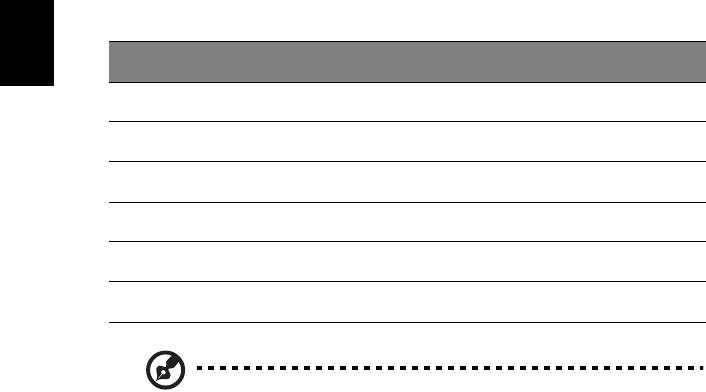
1 Getting to know your TravelMate26
English
2 The DVD movie will automatically play after a few seconds.
Note: To change the region code, insert a DVD movie of a
different region into the DVD-ROM drive. Please refer to the
online help for more information.
Region code Country or region
1 U.S.A., Canada
2 Europe, Middle East, South Africa, Japan
3 Southeast Asia, Taiwan, Korea (South)
4 Latin America, Australia, New Zealand
5 Former U.S.S.R., parts of Africa, India
6 People's Republic of China
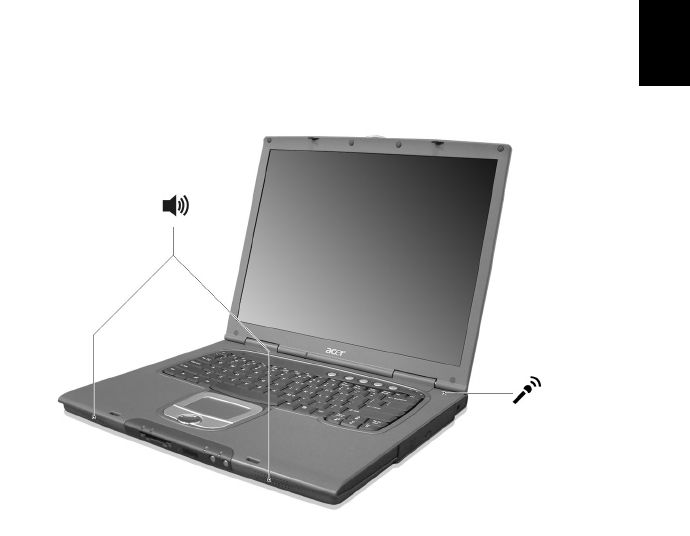
27
English
Audio
The computer comes with 16-bit high-fidelity AC’97 stereo audio, and
includes a built-in sensitive microphone and dual stereo speakers.
There are audio ports on the rear of the computer. See “Rear view” on
page 8 for more information on connecting external audio devices.
Adjusting the volume
Adjusting the volume on the computer is as easy as pressing some
buttons. See “Hot keys” on page 16 for more informations on
adjusting the speaker volume.

1 Getting to know your TravelMate28
English
Power management
This computer has a built-in power management unit that monitors
system activity. System activity refers to any activity involving one or
more of the following devices: keyboard, mouse, floppy drive, hard
disk, peripherals connected to the serial and parallel ports, and video
memory. If no activity is detected for a period of time (called an
inactivity timeout), the computer stops some or all of these devices in
order to conserve energy.
This computer employs a power management scheme that supports
ACPI (Advanced Configuration and Power Interface), which allows for
maximum power conservation and maximum performance at the same
time. Windows handles all power-saving chores for your computer.

29
English
Moving around with your TravelMate
This section gives you tips and hints to consider when moving around
or traveling with your computer.
Disconnecting from the desktop
Follow these steps to disconnect your computer from external
accessories:
1 Save your work in progress.
2 Remove any media, diskette or compact disc, from the drive(s).
3 Shut down the computer.
4 Close the display cover.
5 Disconnect the cord from the AC adapter.
6 Disconnect the keyboard, pointing device, printer, external
monitor, and other external devices.
7 Disconnect the Kensington lock if you are using one to secure the
computer.
Moving around
“when you are just moving within short distances, for example, from
your office desk to a meeting room”
Preparing the computer
Before moving the computer, close and latch the display cover to place
it in Sleep mode. You can now safely take the computer anywhere you
go within the building. To bring the computer out of Sleep mode,
open the display; then slide and release the power switch.
If you are taking the computer to a client's office or a different
building, you may choose to shut down the computer:
1 Click on Start, Shut Down... or Turn off Computer (Windows
XP).
2 Select Shut down and click on OK, or select Turn Off (Windows
XP).

1 Getting to know your TravelMate30
English
- or -
you can put the computer in Sleep mode by pressing Fn-F4. Then close
and latch the display.
When you are ready to use the computer again, unlatch and open the
display; then slide and release the power switch.
Note: If the sleep indicator is off, the computer has entered
Hibernation mode and turned off. If the power indicator is off but
the sleep indicator is on, the computer has entered Sleep mode. In
both cases, slide and release the power switch to turn the
computer back on. Note that the computer may enter Hibernation
mode after it is in Sleep mode for a period of time.
What to bring to short meetings
A fully charged battery runs the computer for about 3 hours under
most circumstances. If your meeting is shorter than that, you probably
do not need to bring anything with you other than the computer.
What to bring to long meetings
If your meeting will last longer than 3 hours or if your battery is not
fully charged, you may want to bring the AC adapter with you to plug
in your computer in the meeting room.
If the meeting room does not have an electrical outlet, reduce the
drain on the battery by putting the computer in Sleep mode. Press Fn-
F4 or close the display cover whenever you are not actively using the
computer. To resume, open the display (if closed); then slide and
release the power switch.
Taking the computer home
“when you are moving from your office to your home or vice versa”
Preparing the computer
After disconnecting the computer from your desktop, follow these
steps to prepare the computer for the trip home:
•Check if you have removed all media, diskettes and compact discs,

31
English
from the drive(s). Failure to remove the media can damage the
drive head.
•Pack the computer in a protective case that can prevent the
computer from sliding around and cushion it if it should fall.
Caution: Avoid packing items next to the top cover of the
computer. Pressure against the top cover can damage the screen
What to bring with you
Unless you already have some items at home, bring the following items
with you:
•AC adapter and power cord
•The printed user’s guide
•AcerMedia drive module(s)
Special considerations
Follow these guidelines to protect your computer while traveling to
and from work:
•Minimize the effect of temperature changes by keeping the
computer with you.
•If you need to stop for an extended period of time and cannot
bring the computer with you, leave the computer in the trunk of
the car to avoid exposing the computer to excessive heat.
•Changes in temperature and humidity can cause condensation.
Allow the computer to return to room temperature, and inspect
the screen for condensation before turning on the computer. If the
temperature change is greater than 18°F (10°C), allow the
computer to come to room temperature slowly. If possible, leave
the computer for 30 minutes in an environment with a
temperature between outside and room temperature.
Setting up a home office
If you frequently work on your computer at home, you may want to
purchase a second AC adapter for use at home. With a second AC
adapter, you can avoid transporting the extra weight to and from
home.

1 Getting to know your TravelMate32
English
If you use your computer at home for significant periods of time, you
might also want to add an external keyboard, monitor, or mouse.
Traveling with the computer
“when you are moving within a larger distance, for instance, from your
office building to a client’s office building or traveling locally”
Preparing the computer
Prepare the computer as if you were taking it home. Make sure that
the battery in the computer is charged. Airport security may require
you to turn on your computer when bringing it into the gate area.
What to bring with you
Bring the following items with you:
•AC adapter
•Spare, fully-charged battery pack(s)
•AcerMedia drive module(s)
•Additional printer driver files if you plan to use another printer
Special considerations
In addition to the guidelines for taking the computer home, follow
these guidelines to protect your computer while traveling:
•Always take the computer as carry-on luggage.
•If possible, have the computer inspected by hand. Airport security
X-ray machines are safe, but do not put the computer through a
metal detector.
•Avoid exposing floppy disks to hand-held metal detectors.
Traveling internationally with the computer
“when you are moving from country to country”
Preparing the computer
Prepare the computer as you would normally prepare it for traveling.

33
English
What to bring with you
Bring the following items with you:
•AC adapter
•Power cords that are appropriate for the country to which you are
traveling
•Spare, fully-charged battery packs
•AcerMedia drive module(s)
•Additional printer driver files if you plan to use another printer
•Proof of purchase, in case you need to show it to customs officials
•International Traveler’s Warranty passport
Special considerations
Follow the same special considerations as when traveling with the
computer. In addition, these tips are useful when traveling
internationally:
•When traveling in another country, check that the local AC voltage
and the AC adapter power cord specifications are compatible. If
not, purchase a power cord that is compatible with the local AC
voltage. Do not use converter kits sold for appliances to power the
computer.
•If you are using the modem, check if the modem and connector is
compatible with the telecommunications system of the country
you are traveling in.
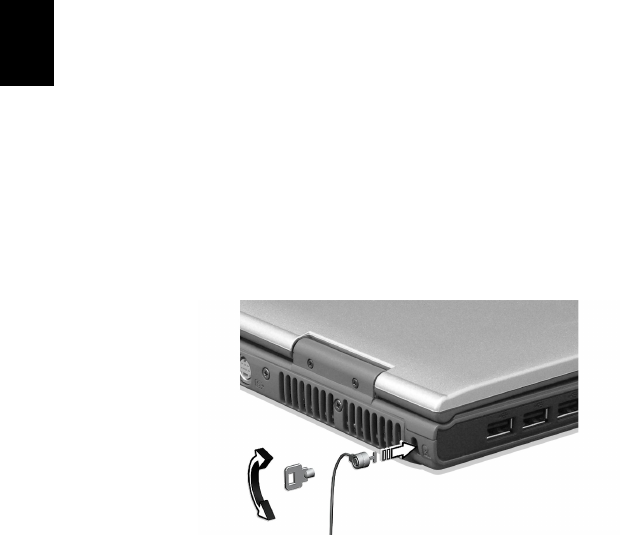
1 Getting to know your TravelMate34
English
Securing your computer
Your computer is a valuable investment that you need to take care of.
Learn how to protect and take care of your computer.
Security features include hardware and software locks — a security
notch, Smart Card and passwords.
Using a computer security lock
A security keylock notch located on the left panel of the computer lets
you connect a Kensington-compatible computer security lock.
Wrap a computer security lock cable around an immovable object such
as a table or locked drawer handle. Insert the lock into the notch and
turn the key to secure the lock. Some keyless models are also available.
Using the Smart Card
This software includes the following components: PlatinumPAS™,
PlatinumSecure™ and PlatinumKey™. Together, they provide you with
multiple levels of security.
• PlatinumPAS implements the first security measure at the BIOS
level and runs during the BIOS routine check when a computer is
powered up or rebooting. If no Smart Card or Emergency Card is
detected, the computer will stop booting up to prevent any illegal
access to the system.
• PlatinumSecure enhances the secure logon procedure for your
Windows at the operating system level. It provides user
authentication through its encryption/decryption function using
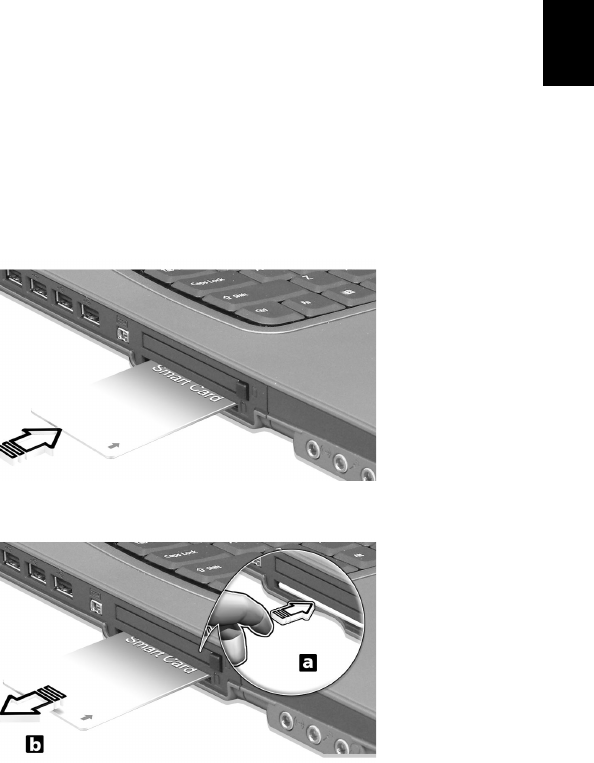
35
English
the Smart Card. If your Smart Card is unavailable, you can use the
Emergency Card as a temporary replacement card.
• PlatinumKey auto-authenticate and auto cache with one-click
logons to all password-required websites (patent pending),
eliminates the overhead costs associated with memorizing and
typing user IDs and passwords when surfing the Internet with
Microsoft or Netscape web browsers.
A slot for your Smart Card is located on the left panel of the computer.
This new security feature helps you boot up your computer with all
your settings built right into your Smart Card. You don’t have to
remember your password to access your computer.
To remove the Smart Card first press the Smart Card (a) and remove the
Smart Card (b) as shown in the illustration below.
For more details consult your Smart Card documentation.
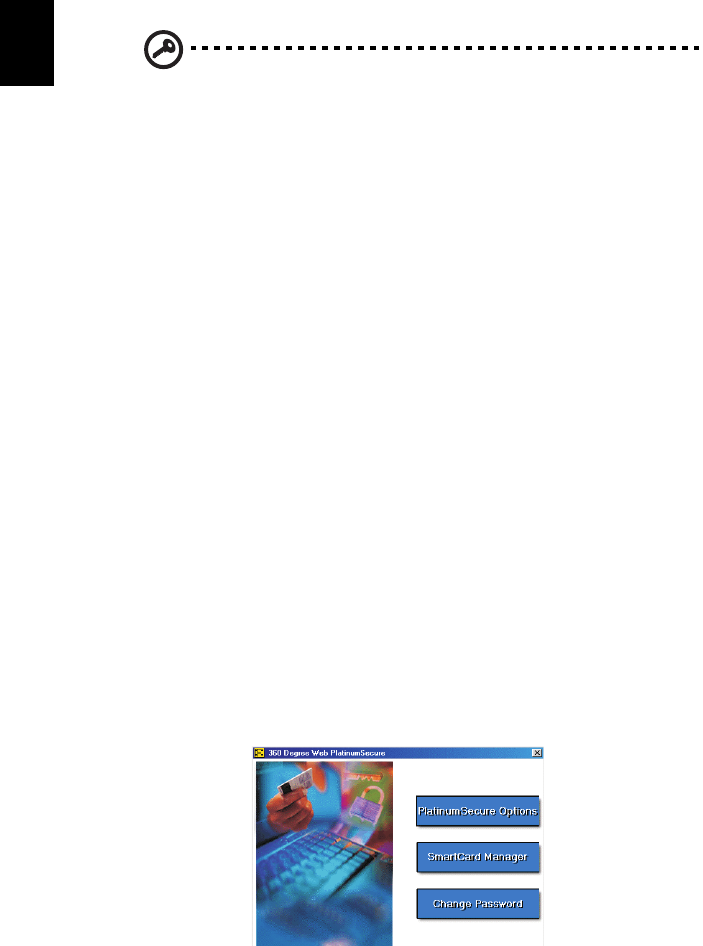
1 Getting to know your TravelMate36
English
Registering your Smart Card
Important! Your Acer notebook is equipped with a Smart Card
security feature that protects the computer from unauthorized
access. If you enable this feature, please make sure that your
warranty card is completed and sent back to Acer. This
information will be used by Acer service centers to confirm
ownership in case your Smart Card "key" is lost or damaged.
Registering your notebook with Acer's service center is extremely
important when replacing your lost Smart Card "key".
If you have already bypassed the Smart Card registration, please
reinstall the application as follows:
1 Insert your System CD and reinstall from it.
2 Follow the onscreen instructions.
To enable the Smart Card security feature, please refer to your Smart
Card user manual.
Running PlatinumSecure
PlatinumSecure enhances the secure logon procedure for Windows
2000 or XP at the operating system level. It provides user
authentication with an encryption/decryption function using the Smart
Card. If your Smart Card is unavailable, the Emergency Card can serve
as a temporary replacement for the Smart Card. After installation, the
PlatinumSecure icon appears on the Windows desktop.
Double-click on it or click the right mouse button, then select Open
from the pop-up menu (or launch it from the PlatinumSecret program
group). From the menu that appears, you can directly access three
operations: PlatinumSecure Options, Smart Card Manager, and Change
Password.
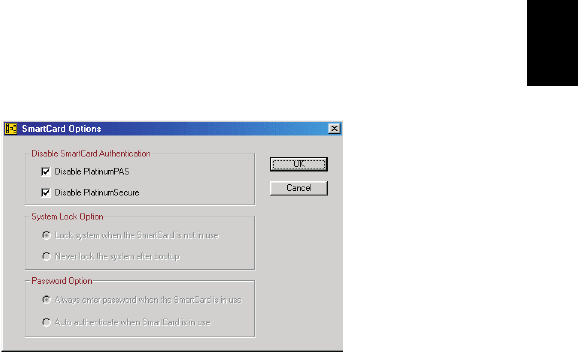
37
English
PlatinumSecure Options
Click on the PlatinumSecure Options button to open the Smart Card
Options window. It provides great flexibility to meet the various
privacy protection needs of many different users.
• Disable Smart Card Authentication
When Disable PlatinumPAS is selected, the PlatinumPAS Preboot
Authentication System will be disabled.
When Disable PlatinumSecure is selected, the PlatinumSecure
Windows Logon Authentication with the Smart Card will be
disabled, which means that the protection of your PC as well as
other options under System Lock Option and Password Option
will be disabled, too. The Smart Card password is required for this
selection.
• System Lock Option
When Lock system when the Smart Card is not in use
(default) is selected, if the Smart Card is removed, the
PlatinumSecure screensaver comes up and access to the system is
locked. When Never lock the system after bootup is selected,
there is no protection for the PC after boot up, and Password
Option is disabled.
• Password Option
When Always enter password when the Smart Card is in use
(default) is selected, the password is required whenever you need
to regain access to the system while the Smart Card is inserted.
When Auto authenticate when Smart Card is in use is
selected, no password is required. All you need to do is insert the
Smart Card.
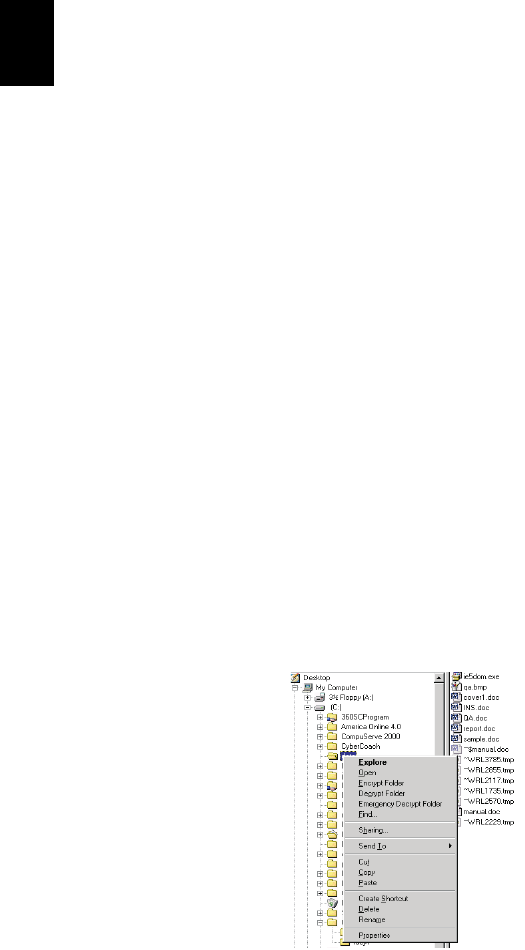
1 Getting to know your TravelMate38
English
Smart Card Manager
The Multiple user support is implemented and managed in Smart Card
Manager. Please note that five users can be registered on one PC. If
you registered as the Primary User, ONLY you can add/remove other
users. If you registered as a regular user, other registered users could
add/remove you. All registered users will be able to use the View Smart
Card users option.
Change Password
Click the Change Password button, fill in the three fields in the
Change Password dialog box, and then close the dialog box by clicking
the OK button to change the Smart Card password.
Encrypt/Decrypt
PlatinumSecure can also be used to encrypt/decrypt files except for
system files or files that are already encrypted with other applications.
Double-click on a file to automatically encrypt/decrypt it. However, if
the file is associated with an application, it will be opened with that
application instead of being encrypted. Note that the encryption is not
recursive, i.e., when you encrypt a folder, only the files immediately
under that folder are encrypted. Other files under subfolders are not.
To find the Encrypt/Decrypt commands:
•Right-click on the Start menu,
•Right-click on a folder or icon on your Windows desktop, or
•In Windows Explorer, right-click on a selected folder, file, or group
of files.

39
English
Running PlatinumKey
PlatinumKey provides one-click logon to all password-required
websites. With its unique Smart Card caching technology, you can
greatly extend the limited card memory size to unlimited use by
storing your private data in an encrypted file either on the Smart Card,
or on the 360 Degree Web secure website server.
Information in PlatinumKey like the one in My Info and Credit Cards,
can be transferred to other applications using the "drag-and-drop"
method: simply point the cursor to the field containing the
information, press and hold the left mouse button, then drag the
cursor to the application and drop the information there.
PlatinumKey also makes it convenient to change your password. There
is always a PWD button available, which is equivalent to the Change
Password button in PlatinumSecure.
Follow these steps to use PlatinumKey:
1 Open your browser to connect to the Internet.
2 Double-click on the PlatinumKey icon on your Windows desktop.
3 Enter your Smart Card password and click OK.
4 If PlatinumKey is being used for the very first time, it will ask
"Would you like to link to 360 Degree Web secure website server
to backup the information on your Smart Card?" The default
answer is Yes, and it will enable you to store your information
(excluding the Credit Cards) on the 360 Degree Web secure
website server for backup purposes in case the card is lost/stolen. If
you choose No, you will only be able to save My Info, Credit Cards
and 5 Websites on your Smart Card.
5 Log in to a website where you are already registered.
6 PlatinumKey automatically stores your login data and asks for your
confirmation to automatically log you in the next time you access
the site. Click Yes and continue browsing.
7 To close PlatinumKey when you are finished browsing, right-click
on the PlatinumKey icon on your Windows taskbar and select
Close PlatinumKey.
PlatinumKey provides a list of all the logon pages that you have stored.
To go directly to any site on the list either double-click it or select it
and click the Go button. Also, you can click the View button to view
the selected website information including Web Name, User Name,

1 Getting to know your TravelMate40
English
Password, and Web URL. Similarly, type the first letter(s) of a site on
the list, and the site will be searched and selected.
You can Edit and Delete the sites as well as other information, and
Save or Cancel the changes you made, by selecting the button
corresponding to each command.
Using passwords
Passwords protect your computer from unauthorized access. Setting
these passwords creates several different levels of protection for your
computer and data:
•Supervisor Password prevents unauthorized entry into the BIOS
Utility. Once set, you must key-in this password to gain access to
the BIOS Utility. See “BIOS Utility” on page 54.
•User Password secures your computer against unauthorized use.
Combine the use of this password with password checkpoints on
boot-up and resume from hibernation for maximum security.
•Password on Boot secures your computer against unauthorized
use. Combine the use of this password with password checkpoints
on boot-up and resume from hibernation for maximum security.
•Hard Disk Password protects your data by preventing
unauthorized access to your hard disk. Even if the hard disk is
removed from the computer and moved to another computer, it
cannot be accessed without the Hard Disk Password.
Important! Do not forget your Supervisor and Hard Disk
Password! If you forget your password, please get in touch with
your dealer or an authorized service center.
Entering passwords
When a password is set, a password prompt appears in the left-hand
corner of the display screen.
•When the Supervisor Password is set, a prompt appears when you
press F2 to enter the BIOS Utility at boot-up.
•Type the Supervisor Password and press Enter to access the BIOS
Utility. If you enter the password incorrectly, a warning message
appears. Try again and press Enter.
•When the User Password is set and the Password on boot

41
English
parameter is enabled, a prompt appears at boot-up.
•Type the User Password and press Enter to use the computer. If
you enter the password incorrectly, a warning message appears.
Try again and press Enter.
•When the Hard Disk Password is set, a prompt appears at boot-up.
•Type the Hard Disk Password and press Enter to use the computer.
If you enter the password incorrectly, a warning message appears.
Try again and press Enter.
Important! You have three chances to enter a password. If you
fail to enter the password correctly after three tries, the system
halts. Slide and hold the power switch for four seconds to shut
down the computer. Then turn on the computer again, and try
again. If you fail to enter the Hard Disk Password, please contact
your dealer or an authorized service center.
Setting passwords
You can set passwords using the BIOS Utility.

1 Getting to know your TravelMate42
English

2 Customizing my
computer

After learning the basics of your TravelMate
computer, let’s get acquainted with the
advanced features of your computer. In this
chapter, you will learn how to add options,
upgrade components for better performance,
and customize your computer.
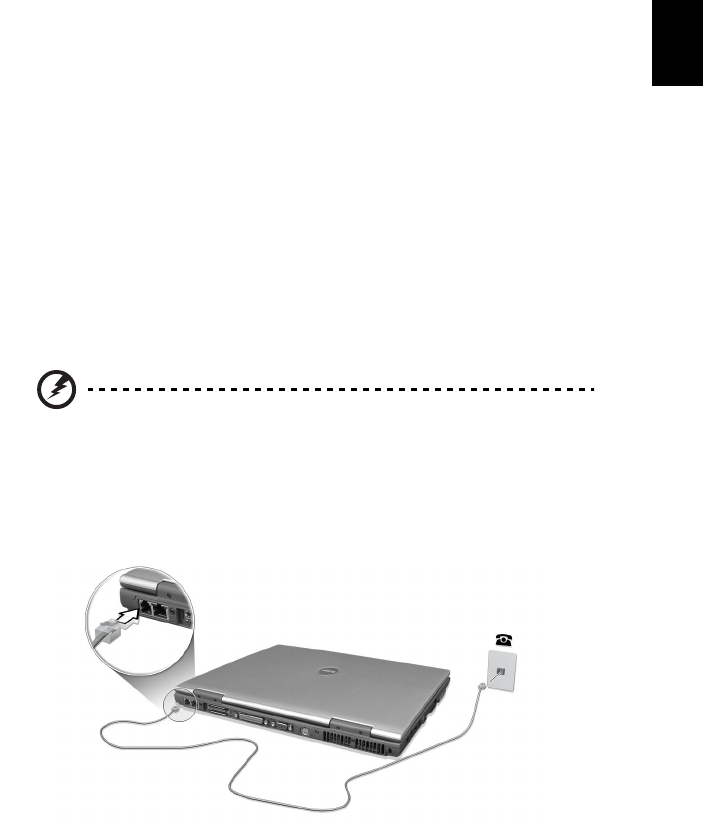
45
English
Expanding through options
Your TravelMate offers you a complete mobile computing experience.
Connectivity options
Ports allow you to connect peripheral devices to your computer as you
would with a desktop PC. For instructions on how to connect different
external devices to the computer, see your online guide for more
details.
Fax/data modem
Your computer has a built-in V.90/92 56Kbps AC’97 Link fax/data
modem.
Warning! This modem port is not compatible with digital
phone lines. Plugging this modem into a digital phone line
will damage the modem.
To use the fax/data modem port, connect a phone cable from the
modem port to a telephone jack.
Start your communications software program.
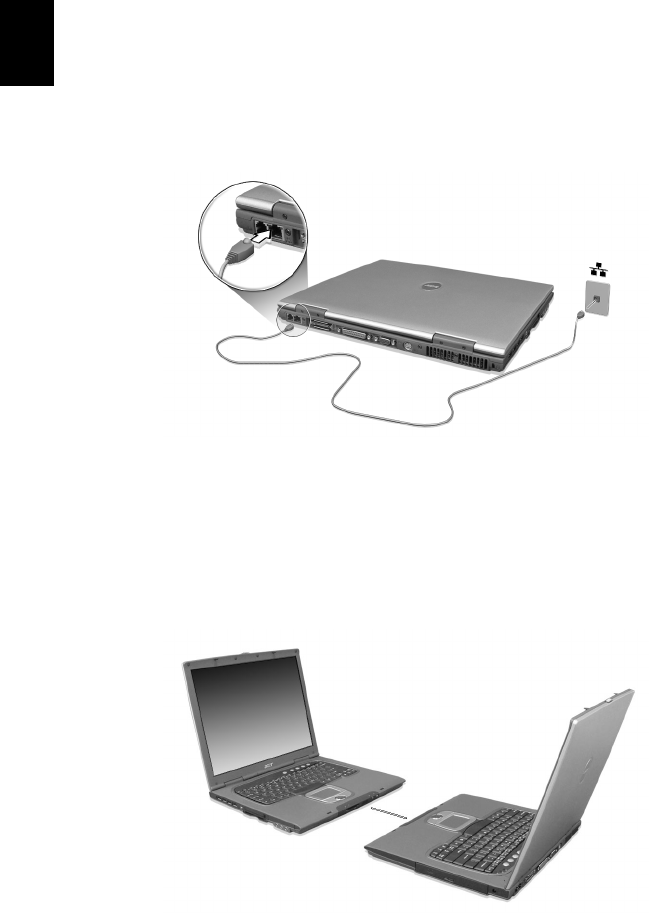
2 Customizing my computer46
English
Built-in network feature
The built-in network feature allows you to connect your computer to
an Ethernet-based (10/100 Mbps) network.
To use the network feature, connect an Ethernet cable from the
network jack on the rear of the computer to a network jack or hub on
your network.
Fast infrared
The computer’s fast infrared (FIR) port allows you to do wireless data
transfer with other IR-aware computers and peripherals such as PDAs
(personal digital assistants), mobile phones, and infrared printers. The
infrared port can transfer data at speeds of up to four megabits per
second (Mbps) at a distance of up to one meter.
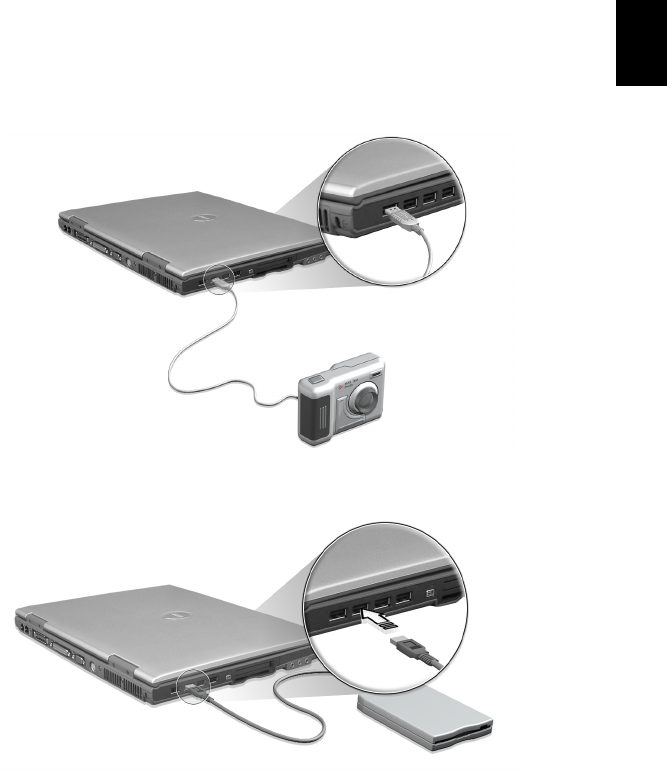
47
English
Universal Serial Bus
The Universal Serial Bus (USB 2.0) port is a high-speed serial bus which
allows you to connect and daisy-chain USB peripherals without taking
up precious system resources. Your computer has four ports available.
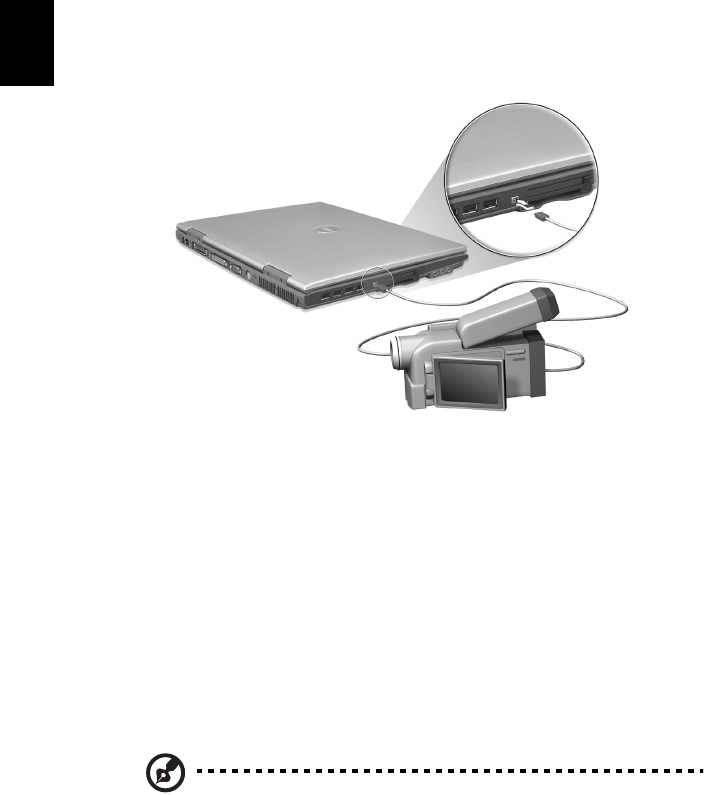
2 Customizing my computer48
English
IEEE 1394 port
The computer's IEEE 1394 port allows you to connect to an IEEE 1394
supported devices like a video camera or digital camera.
See your video or digital camera's documentation for details.
PC Card slot
The type II CardBus PC Card slot found on the left side of the computer
accepts credit-card-sized cards that enhance the usability and
expandability of the computer. These cards should have a PC Card logo
on them.
PC Cards (formerly PCMCIA) are add-on cards for portable computers,
giving you expansion possibilities long afforded by desktop PCs.
Popular PC cards include flash, fax/data modem, LAN, wireless LAN and
SCSI cards. CardBus improves on the 16-bit PC card technology by
expanding the bandwidth to 32 bits.
Note: Refer to your card’s manual for details on how to install and
use the card and its functions.
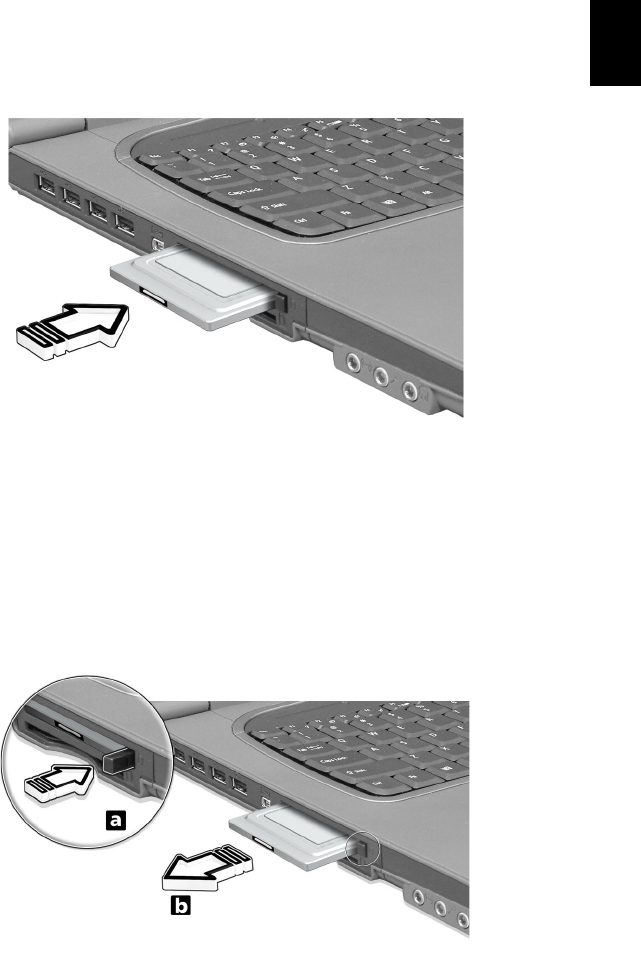
49
English
Inserting a PC Card
Insert the card into the slot and make the proper connections (e.g.,
network cable), if necessary. See your card manual for details.
Ejecting a PC Card
Before ejecting a PC Card:
1 Exit the application using the card.
2 Left-click on the PC Card icon on the taskbar and stop the card
operation.
3 Press the slot eject button to pop out the eject button (a); then
press it again to eject the card (b).

2 Customizing my computer50
English
Port expansion devices
Two types of expansion devices are available for your computer:
•I/O replicator - adds serial port and parallel port connections to
your computer.
•EasyPort - adds a host of ports for your computer, and allows you
to connect and disconnect peripherals from your computer in one
quick step.
See your dealer for more information.
Upgrade options
Your computer delivers superior power and performance. However,
some users and the applications they use may demand more. This
computer allows you to upgrade key components when you need
increased performance.
Note: Contact your authorized dealer if you decide to perform a
key component upgrade.
Memory upgrade
Memory is expandable to 2 GB (only one slot for user accessible),
employing 256/512-MB industry standard soDIMMs (Small Outline Dual
Inline Memory Modules). The computer supports DDR (Double Data
Rate) RAM.
There are two memory slots on your computer, one of which is
occupied by standard memory. You can upgrade memory by installing
a memory module into the one available slot, or replacing the standard
memory with a higher-capacity memory module.
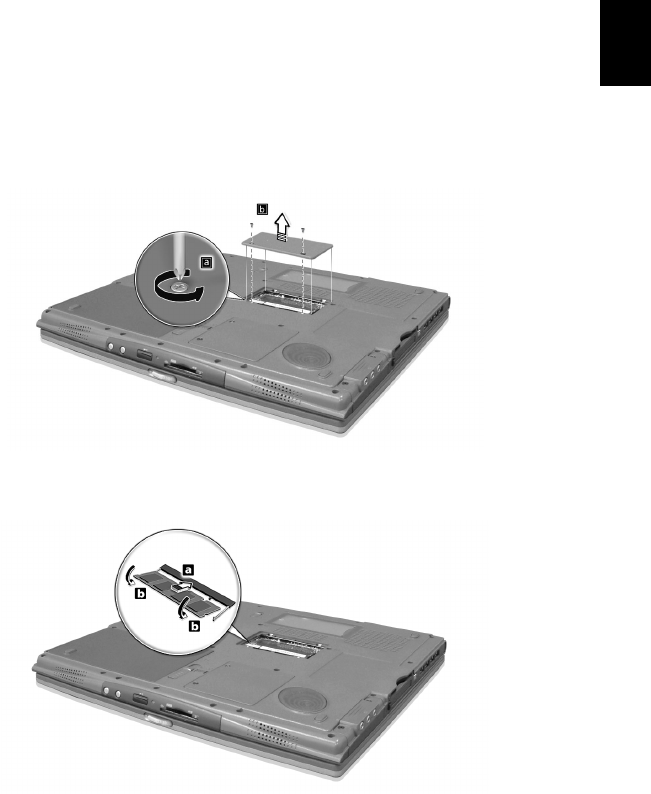
51
English
Installing memory
Follow these steps to install memory:
1 Turn off the computer, unplug the AC adapter (if connected) and
remove the battery pack. Then turn the computer over to access its
base.
2 Remove the screws from the memory cover (a); then lift up and
remove the memory cover (b).
3 Insert the memory module diagonally into the slot (a), then gently
press it down (b) until it clicks into place.
4 Replace the memory cover and secure it with the screw.
5 Reinstall the battery pack, and reconnect the AC adapter.
6 Turn on the computer.
The computer automatically detects and reconfigures the total
memory size.
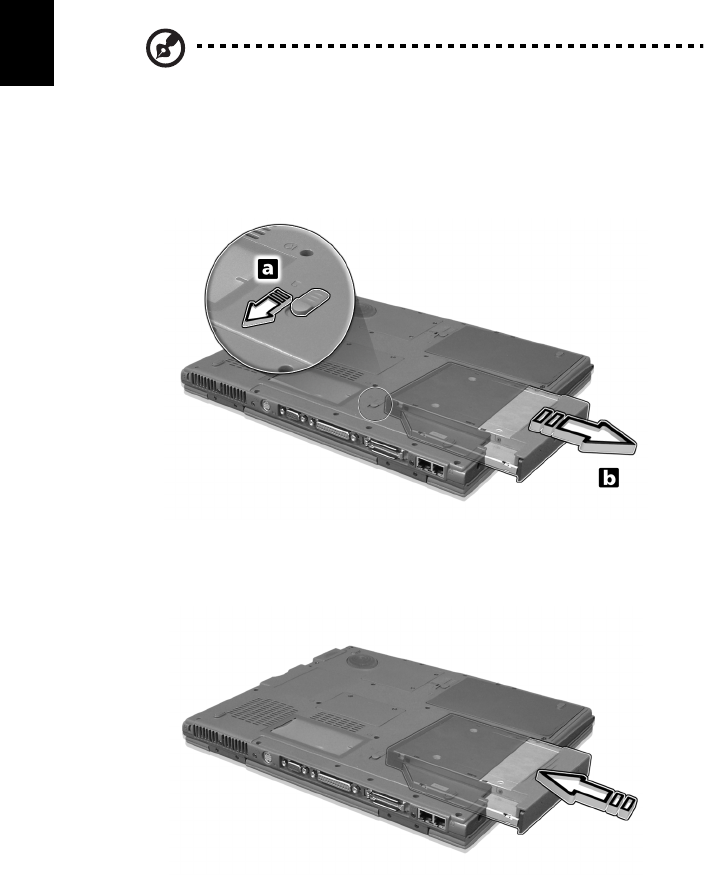
2 Customizing my computer52
English
Swapping AcerMedia drive modules
Note: The hard disk drive module is not hot-swappable. You have
to turn off your computer before you can swap the module.
You can swap the AcerMedia drive with any optional AcerMedia
modules. First slide the AcerMedia release latch as shown in the
illustration (a). Then remove the optical drive from the AcerMedia bay
(b).
Then insert the optional AcerMedia module into the AcerMedia bay
until the it click into place.
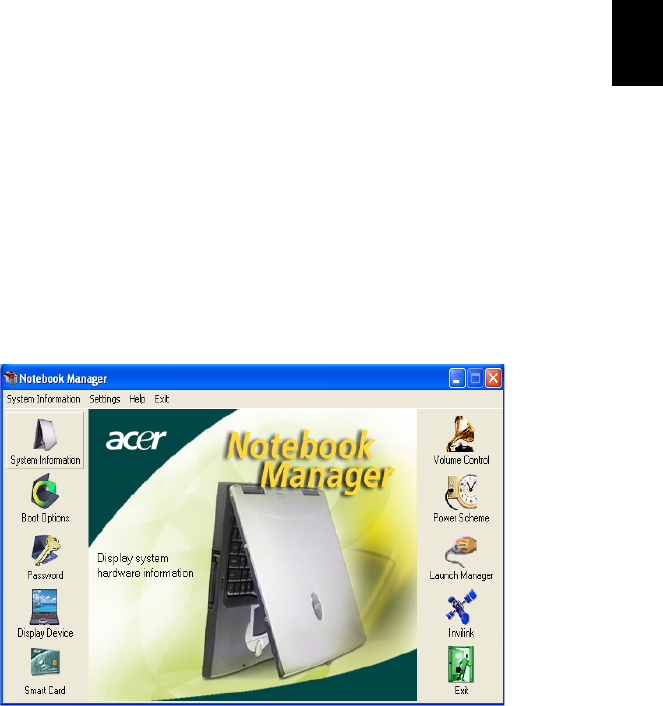
53
English
Using system utilities
Notebook Manager
The computer has a built-in system setup program called Notebook
Manager. The Windows-based Notebook Manager allows you to set
passwords, the startup sequence of the drives, and power
management settings. It also shows current hardware configurations.
To start the Notebook Manager, press Fn-F2 or follow these steps:
1 Click on Start, Programs, then Notebook Manager.
2 Select the Notebook Manager application to run the program.
Click on Help for more information.
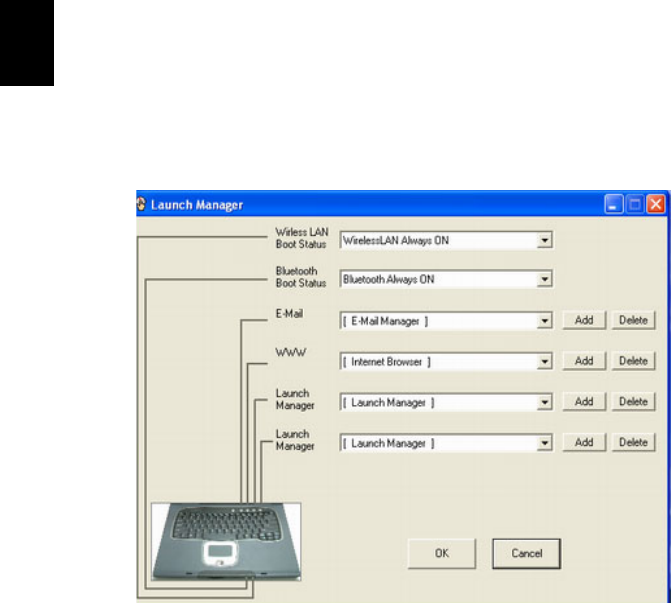
2 Customizing my computer54
English
Launch Manager
Launch Manager allows you to set the four launch keys located above
the keyboard. See “Launch Keys” on page 21 for the location of the
launch key.
You can access the Launch Manager by clicking on Start, Programs,
and then Launch Manager to start the application.
BIOS Utility
The BIOS Utility is a hardware configuration program built into your
computer’s BIOS (basic input/output system).
Your computer is already properly configured and optimized, and you
do not need to run this utility. However, if you encounter
configuration problems, you may need to run it.
To activate the BIOS Utility, press F2 during the POST (power-on self-
test) while the TravelMate logo is being displayed.

3 Troubleshooting my
computer

This chapter instructs you on how to deal with
common system problems. Read it before
calling a technician if a problem occurs.
Solutions to more serious problems require
opening up the computer. Do not attempt to
open the computer by yourself. Contact your
dealer or an authorized service center for
assistance. key link: www.acersupport.com

57
English
Frequently-asked questions
The following is a list of possible situations that may arise during the
use of your computer. Easy answers and solutions are provided for
each one.
I slid the power switch and opened the display, but the computer does
not start or boot-up.
Look at the Power indicator:
•If it is not lit, no power is being applied to the computer. Check the
following:
•If you are running on battery power, it may be low and unable
to power the computer. Connect the AC adapter to recharge
the battery pack.
•Make sure that the AC adapter is plugged in properly to the
computer and to the power outlet.
•If it is lit, check the following:
•Is a non-bootable (non-system) diskette in the floppy drive?
Remove or replace it with a system diskette and press Ctrl-Alt-
Del to restart the system.
•The operating system files may be damaged or missing. Insert the
startup disk you created during Windows setup into the floppy
drive and press Ctrl-Alt-Del to restart the system. This will
diagnose your system and make necessary fixes.
Nothing appears on the screen.
The computer’s power management system automatically blanks the
screen to save power. Press any key to turn the display back on.
If pressing a key does not turn the display back on, two things might
be the cause:
•The brightness level might be too low. Press Fn-→ (increase) and
Fn-← (decrease) to adjust the brightness level.
•The display device might be set to an external monitor. Press the
display toggle hot key Fn-F5 to toggle the display back to the
computer.
•If the Sleep indicator is lit, the computer is in Sleep mode. Slide
and release the power switch to resume.

3 Troubleshooting my
computer

This chapter instructs you on how to deal with
common system problems. Read it before
calling a technician if a problem occurs.
Solutions to more serious problems require
opening up the computer. Do not attempt to
open the computer by yourself. Contact your
dealer or an authorized service center for
assistance. key link: www.acersupport.com

57
English
Frequently-asked questions
The following is a list of possible situations that may arise during the
use of your computer. Easy answers and solutions are provided for
each one.
I slid the power switch and opened the display, but the computer does
not start or boot-up.
Look at the Power indicator:
•If it is not lit, no power is being applied to the computer. Check the
following:
•If you are running on battery power, it may be low and unable
to power the computer. Connect the AC adapter to recharge
the battery pack.
•Make sure that the AC adapter is plugged in properly to the
computer and to the power outlet.
•If it is lit, check the following:
•Is a non-bootable (non-system) diskette in the floppy drive?
Remove or replace it with a system diskette and press Ctrl-Alt-
Del to restart the system.
•The operating system files may be damaged or missing. Insert the
startup disk you created during Windows setup into the floppy
drive and press Ctrl-Alt-Del to restart the system. This will
diagnose your system and make necessary fixes.
Nothing appears on the screen.
The computer’s power management system automatically blanks the
screen to save power. Press any key to turn the display back on.
If pressing a key does not turn the display back on, two things might
be the cause:
•The brightness level might be too low. Press Fn-→ (increase) and
Fn-← (decrease) to adjust the brightness level.
•The display device might be set to an external monitor. Press the
display toggle hot key Fn-F5 to toggle the display back to the
computer.
•If the Sleep indicator is lit, the computer is in Sleep mode. Slide
and release the power switch to resume.
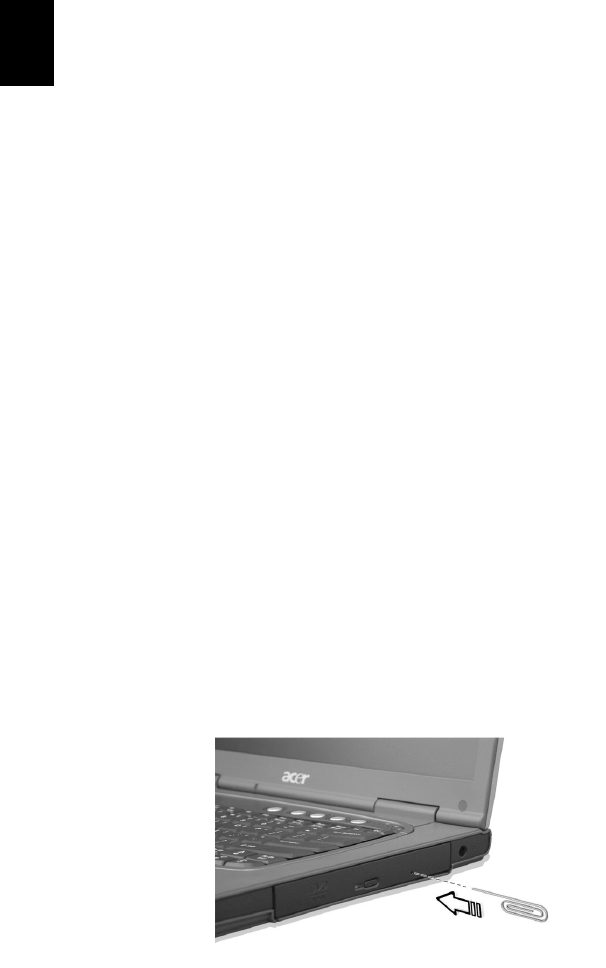
3 Troubleshooting my computer58
English
Image is not full-screen.
The computer display has a native resolution of 1024 x 768 (XGA) for
the 14.1” and 1400 x 1050 (SXGA+) for the 15.0”. If you set the
resolution lower than this, the screen expands to fill the computer
display. Right-click on your Windows desktop and select Properties to
bring up the Display Properties dialog box. Then click on the Settings
tab to make sure that the resolution is set to the appropriate
resolution. Resolutions lower than the specified resolution are not full-
screen on the computer or on an external monitor.
No audio is heard from the computer.
Check the following:
•The volume may be muted. In Windows, look at the volume
control (speaker) icon on the taskbar. If it is crossed-out, click on
the icon and deselect the Mute option.
•The speakers may be turned off. Press Fn-F8 to turn the speakers
on (this hot key also turns the speakers off).
•The volume level may be too low. In Windows, look at the volume
control icon on the taskbar. You can also use the volume control
buttons to adjust the volume. See “Hot keys” on page 17 for more
detail.
•If headphones, earphones or external speakers are connected to
the line-out port on the computer’s rear panel, the internal
speakers automatically turn off.
I want to eject the optical drive tray without turning on the power. I
cannot eject the optical drive tray.
There is a mechanical eject button on the optical drive. Simply insert
the tip of a pen or paperclip and push to eject the tray.

59
English
The keyboard does not respond.
Try attaching an external keyboard to the USB 2.0 connector on the
rear of the computer. If it works, contact your dealer or an authorized
service center as the internal keyboard cable may be loose.
The infrared port does not work.
Check the following:
•Make sure that the infrared ports of the two devices are facing
each other (+/- 15 degrees) a maximum of 1 meter apart.
•Make sure there is a clear path between the two infrared ports.
Nothing should be blocking the ports.
•Make sure you have the appropriate software running on both
devices (for file transfers) or you have the appropriate drivers (for
printing to an infrared printer).
•During the POST, press F2 to access the BIOS Utility and verify that
the infrared port is enabled.
•Make sure both devices are IrDA-compliant.
The printer does not work.
Check the following:
•Make sure that the printer is connected to a power outlet and that
it is turned on.
•Make sure that the printer cable is connected securely to the
computer’s parallel port and the corresponding port on the
printer.
•During POST, press F2 to access the BIOS Utility and verify that the
parallel port is enabled.
I want to set up my location to use the internal modem.
To properly use your communications software (e.g., HyperTerminal),
you need to set up your location:
1 Click on Start, Settings, Control Panel.
2 Double-click on Modems.
3 Click on Dialing Properties and begin setting up your location.
Refer to the Windows manual.

3 Troubleshooting my computer60
English
Troubleshooting tips
This notebook computer incorporates an advanced design that delivers
onscreen error message reports to help you solve problems.
If the system reports an error message or an error symptom occurs, see
“Error messages” on page 61. If the problem cannot be resolved,
contact your dealer. See “Requesting service” on page 62.
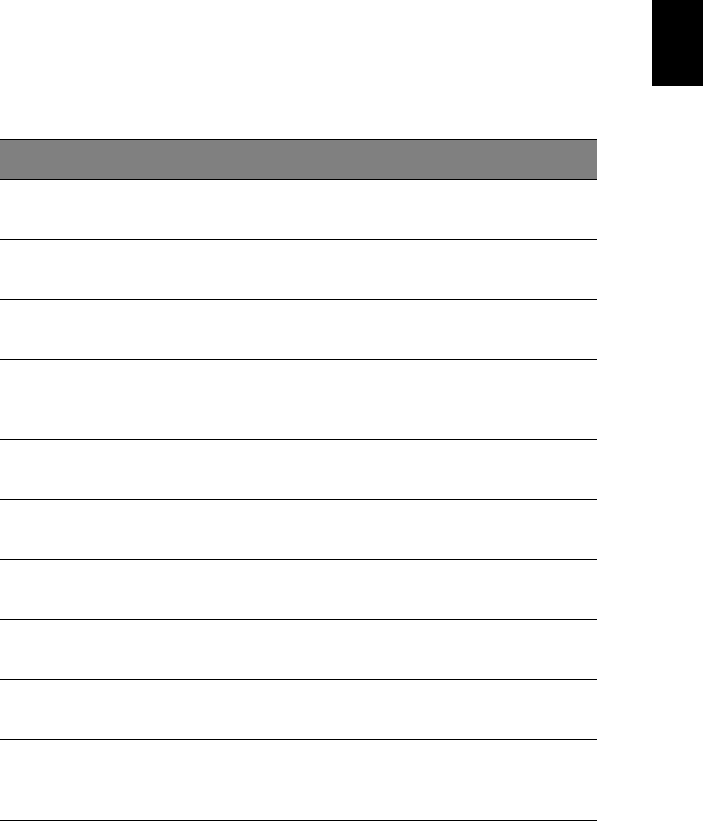
61
English
Error messages
If you receive an error message, note the message and take the
corrective action. The following table lists the error messages in
alphabetical order together with the recommended course of action.
If you still encounter problems after going through the corrective
measures, please contact your dealer or an authorized service center
for assistance. Some problems may be solved using the BIOS Utility.
Error Messages Corrective Action
CMOS Battery Bad Contact your dealer or an authorized service
center.
CMOS Checksum Error Contact your dealer or an authorized service
center.
Disk Boot Failure Insert a system (bootable) diskette into the floppy
drive (A:), then press Enter to reboot.
Equipment
Configuration Error Press F2 (during POST) to enter the BIOS Utility;
then press Esc to exit and reconfigure the
computer.
Hard Disk 0 Error Contact your dealer or an authorized service
center.
Hard Disk 0 Extended
Type Error Contact your dealer or an authorized service
center.
I/O Parity Error Contact your dealer or an authorized service
center.
Keyboard Error or No
Keyboard Connected Contact your dealer or an authorized service
center.
Keyboard Interface
Error Contact your dealer or an authorized service
center.
Memory Size Mismatch Press F2 (during POST) to enter the BIOS Utility;
then press Esc to exit and reconfigure the
computer.

3 Troubleshooting my computer62
English
Requesting service
International Traveler’s Warranty (ITW)
Your computer is backed by an International Traveler’s Warranty (ITW)
that gives you security and peace of mind when traveling. Our
worldwide network of service centers are there to give you a helping
hand.
An ITW passport comes with your computer. This passport contains all
you need to know about the ITW program. A list of available,
authorized service centers is in this handy booklet. Read this passport
thoroughly.
Always have your ITW passport on hand, especially when you travel to
receive the benefits from our support centers. Place your proof-of-
purchase in the flap located inside the front cover of the ITW passport.
If the country you are traveling in does not have an Acer-authorized
ITW service site, you can still get in contact with our offices worldwide.
There are two ways to access Acer for technical support and
information:
•Internet service worldwide (www.acersupport.com)
•Technical support numbers in various countries
You can view a list of technical support numbers by following these
steps:
1 Click on Start, Settings, Control Panel.
2 Double-click on System.
3 Click on the Support Information button.
Before you call
Please have the following information available when you call Acer for
online service, and please be at your computer when you call. With
your support, we can reduce the amount of time a call takes and help
solve your problems efficiently.
If there are error messages or beeps reported by your computer, write
them down as they appear on the screen (or the number and sequence
in the case of beeps).

63
English
You are required to provide the following information:
Name:________________________________________
Address:______________________________________
______________________________________________
Telephone number:____________________________
Machine and model type:_______________________
Serial number:_________________________________
Date of purchase:______________________________

3 Troubleshooting my computer64
English

Appendix A
Specifications

This appendix lists the general specifications
of your computer.

67
English
Microprocessor
•Intel® Pentium® M Processor at 1.3~1.6G and higher
•L2 cache 1024KB
•Intel® 855 GM with ICH4-M, support 400Mhz Bus
Memory
•Main memory expandable up to 2 GB
•Two DDR DIMM slots (Only one slot for user accessible)
•Support 256M, 512M & 1G DDR RAM modules
•512 KB Flash ROM BIOS
Data storage
•One high-capacity, Enhanced-IDE hard disk
•One 5.25-inch internal removable optical drive (AcerMedia bay)
Display and video
•Thin-Film Transistor (TFT) liquid crystal display (LCD) displaying 32-
bit true color up to 1024 x 768 eXtended Graphics Array (XGA)
resolution for 14.1”/15” and 1400 x 1050 Super eXtended Graphics
Array + (SXGA+) resolution for 15” models (specification varies
depending on the model)
•4X AGP bus with 3D acceleration
•Simultaneous LCD and CRT display support
•Dual independent display
•S-video for output to a television or display device that supports S-
video input
•"Automatic LCD dim" feature that automatically decides the best
settings for your display and conserves power
Audio
•16-bit AC’97 stereo audio
•Dual speakers and one internal microphone
•Separate audio ports for headphone-out, line-in and microphone-
in devices

Appendix A Specifications68
English
Keyboard and pointing device
•84-/85-/88-key Windows keyboard
•Ergonomically-centered touchpad pointing device with 4-way
scroll button
I/O ports
•One type II CardBus PC Card slot
•One RJ-45 jack (Ethernet 10/100)
•One RJ-11 phone jack (V.90/92)
•One DC-in jack for AC adapter
•One parallel port
•One VGA port for external monitor
•One speaker/headphone-out jack (3.5mm mini jack)
•One audio line-in jack (3.5mm mini jack)
•One microphone-in jack
•One IEEE 1394 port
•One S-video TV-out port
•One 100-pin port replicator
•Four USB 2.0 ports
•One FIR port (IrDA)
•One Smart Card slot
•4-in-1 Card Reader (Manufacture optional)
Weight and dimensions
•2.76 kg (6.1 lbs) for 14.1” LCD model/ 2.86kg (6.3 lbs) for 15” LCD
model
•330mm (W) x 272mm (D) x 28.9~31.8mm (H)
Environment
•Temperature
•Operating: 5°C ~ 35°C
•Non-operating: -20°C ~ 65°C
•Humidity (non-condensing)
•Operating: 20% ~ 80% RH

69
English
•Non-operating: 20% ~ 80% RH
System
•ACPI support
•DMI 2.0-compliant
•Microsoft Windows operating system
Power
•Battery pack
•Up to 62.16WH capacity Li-ion battery pack
•5 hrs operation time on main battery with Battery mark 4.0
(Estimated)
•Charging time 3.5 hrs (System on)
•AC adapter
•75-Watt
•Auto sensing 90~264Vac, 47~63Hz
Options
•256MB/512MB/1G memory upgrade modules
•Additional Li-Ion battery pack
•Additional AC adapter
•DVD/CD-RW combo (including DVD playback software)
•Acer EasyPort port replicator
•Second HDD drive
•USB Floppy drive

Appendix A Specifications70
English

Appendix B
Notices

This appendix lists the general notices of your
computer.

73
English
FCC notice
This device has been tested and found to comply with the limits for a Class B
digital device pursuant to Part 15 of the FCC Rules. These limits are designed to
provide reasonable protection against harmful interference in a residential
installation. This device generates, uses, and can radiate radio frequency energy
and, if not installed and used in accordance with the instructions, may cause
harmful interference to radio communications.
However, there is no guarantee that interference will not occur in a particular
installation. If this device does cause harmful interference to radio or television
reception, which can be determined by turning the device off and on, the user
is encouraged to try to correct the interference by one or more of the following
measures:
•Reorient or relocate the receiving antenna
•Increase the separation between the device and receiver
•Connect the device into an outlet on a circuit different from that to which
the receiver is connected
•Consult the dealer or an experienced radio/television technician for help
Notice: Shielded cables
All connections to other computing devices must be made using shielded cables
to maintain compliance with FCC regulations.
Notice: Peripheral devices
Only peripherals (input/output devices, terminals, printers, etc.) certified to
comply with the Class B limits may be attached to this equipment. Operation
with non-certified peripherals is likely to result in interference to radio and TV
reception.
Caution
Changes or modifications not expressly approved by the manufacturer could
void the user’s authority, which is granted by the Federal Communications
Commission, to operate this computer.
Use conditions
This part complies with Part 15 of the FCC Rules. Operation is subject to the
following two conditions: (1) this device may not cause harmful interference,
and (2) this device must accept any interference received, including interference
that may cause undesired operation.

Appendix B Notices74
English
Notice: Canadian users
This Class B digital apparatus meets all requirements of the Canadian
Interference-Causing Equipment Regulations.
Remarque à l’intention des utilisateurs canadiens
Cet appareil numérique de la classe B respected toutes les exigences du
Règlement sur le matériel brouilleur du Canada.
Modem notices
FCC
This equipment complies with Part 68 of the FCC rules. Located on the bottom
side of the modem is a label that contains, among other information, the FCC
Registration Number and Ringer Equivalence Number (REN) for this equipment.
Upon request, you must provide this information to your telephone company.
If your telephone equipment causes harm to the telephone network, the
telephone company may discontinue your service temporarily. If possible, they
will notify you in advance. But, if advance notice is not practical, you will be
notified as soon as possible. You will also be informed of your right to file a
complaint with the FCC.
Your telephone company may make changes in its facilities, equipment,
operations, or procedures that could affect the proper functioning of your
equipment. If they do, you will be notified in advance to give you an
opportunity to maintain uninterrupted telephone service.
If this equipment should fail to operate properly, disconnect the equipment
from the phone line to determine if it is causing the problem. If the problem is
with the equipment, discontinue use and contact your dealer or vendor.
TBR 21
This equipment has been approved [Council Decision 98/482/EC - “TBR 21”] for
pan-European single terminal connection to the Public Switched Telephone
Network (PSTN). However, due to differences between the individual PSTNs
provided in different countries, the approval does not, of itself, give an
unconditional assurance of successful operation on every PSTN termination
point. In the event of problems, you should contact your equipment supplier in
the first instance.

75
English
Important safety instructions
Read these instructions carefully. Save these instructions for future reference.
1Follow all warnings and instructions marked on the product.
2Unplug this product from the wall outlet before cleaning. Do not use
liquid cleaners or aerosol cleaners. Use a damp cloth for cleaning.
3Do not use this product near water.
4Do not place this product on an unstable cart, stand, or table. The product
may fall, causing serious damage to the product.
5Slots and openings in the cabinet and the back or bottom are provided for
ventilation; to ensure reliable operation of the product and to protect it
from overheating, these openings must not be blocked or covered. The
openings should never be blocked by placing the product on a bed, sofa,
rug, or other similar surface. This product should never be placed near or
over a radiator or heat register, or in a built-in installation unless proper
ventilation is provided.
6This product should be operated from the type of power indicated on the
marking label. If you are not sure of the type of power available, consult
your dealer or local power company.
7Do not allow anything to rest on the power cord. Do not locate this
product where persons will walk on the cord.
8If an extension cord is used with this product, make sure that the total
ampere rating of the equipment plugged into the extension cord does not
exceed the extension cord ampere rating. Also, make sure that the total
rating of all products plugged into the wall outlet does not exceed the fuse
rating.
9Never push objects of any kind into this product through cabinet slots as
they may touch dangerous voltage points or short out parts that could
result in a fire or electric shock. Never spill liquid of any kind on the
product.
10 Do not attempt to service this product yourself, as opening or removing
covers may expose you to dangerous voltage points or other risks. Refer all
servicing to qualified service personnel.
11 Unplug this product from the wall outlet and refer servicing to qualified
service personnel under the following conditions:
aWhen the power cord or plug is damaged or frayed
bIf liquid has been spilled into the product
cIf the product has been exposed to rain or water
dIf the product does not operate normally when the operating
instructions are followed. Adjust only those controls that are covered
by the operating instructions since improper adjustment of other

Appendix B Notices76
English
controls may result in damage and will often require extensive work
by a qualified technician to restore the product to normal condition.
eIf the product has been dropped or the cabinet has been damaged
fIf the product exhibits a distinct change in performance, indicating a
need for service.
12 Replace the battery with the same type as the product's battery we
recommend. Use of another battery may present a risk of fire or explosion.
13 Warning! Batteries may explode if not handled properly. Do not
disassemble or dispose of them in fire. Keep them away from children and
dispose of used batteries promptly.
14 Use only the proper type of power supply cord set (provided in your
accessories box) for this unit. It should be a detachable type: UL listed/CSA
certified, type SPT-2, rated 7A 125V minimum, VDE approved or its
equivalent. Maximum length is 15 feet (4.6 meters).
Laser compliance statement
The CD or DVD drive used with this computer is a laser product. The CD
or DVD drive’s classification label (shown below) is located on the
drive.
CLASS 1 LASER PRODUCT
CAUTION: INVISIBLE LASER RADIATION WHEN OPEN. AVOID EXPOSURE TO
BEAM.
APPAREIL A LASER DE CLASSE 1 PRODUIT
LASERATTENTION: RADIATION DU FAISCEAU LASER INVISIBLE EN CAS
D’OUVERTURE. EVITTER TOUTE EXPOSITION AUX RAYONS.
LUOKAN 1 LASERLAITE LASER KLASSE 1
VORSICHT: UNSICHTBARE LASERSTRAHLUNG, WENN ABDECKUNG GEÖFFNET
NICHT DEM STRAHLL AUSSETZEN
PRODUCTO LÁSER DE LA CLASE I
ADVERTENCIA: RADIACIÓN LÁSER INVISIBLE AL SER ABIERTO. EVITE
EXPONERSE A LOS RAYOS.
ADVARSEL: LASERSTRÅLING VEDÅBNING SE IKKE IND I STRÅLEN.
VARO! LAVATTAESSA OLET ALTTINA LASERSÅTEILYLLE.
VARNING: LASERSTRÅLNING NÅR DENNA DEL ÅR ÖPPNAD ÅLÅ TUIJOTA
SÅTEESEENSTIRRA EJ IN I STRÅLEN
VARNING: LASERSTRÅLNING NAR DENNA DEL ÅR ÖPPNADSTIRRA EJ IN I
STRÅLEN
ADVARSEL: LASERSTRÅLING NAR DEKSEL ÅPNESSTIRR IKKE INN I STRÅLEN

77
English
Lithium battery statement
CAUTION
Danger of explosion if battery is incorrectly replaced. Replace only with
the same or equivalent type recommended by the manufacturer.
Dispose of used batteries according to local regulations. Recycle if at all
possible.
ADVARSEL!
Lithiumbatteri - Eksplosionsfare ved fejlagtig håndtering. Udskiftning
må kun ske med batteri af samme fabrikat og type. Léver det brugte
batteri tilbage til leverandøren.
ADVARSEL
Eksplosjonsfare ved feilaktig skifte av batteri. Benytt samme
batteritype eller en tilsvarende type anbefalt av apparatfabrikanten.
Brukte batterier kasseres i henhold til fabrikantens instruksjoner.
VARNING
Explosionsfara vid felaktigt batteribyte. Anvãnd samma batterityp
eller en ekvivalent typ som rekommenderas av apparattillverkaren.
Kassera anvãnt batteri enligt fabrikantens instruktion.
VAROITUS
Päristo voi räjähtää, jos se on virheellisesti asennettu. Vaihda paristo
ainoastaan laitevalmistajan suosittelemaan tyyppiin. Hävitä käytetty
paristo valmistajan ohjeiden mukaisesti.
VORSICHT!
Explosionsgefahr bei unsachgemäßen Austausch der Batterie Ersatz
nur durch denselben oder einem vom Hersteller empfohlenem
ähnlichen Typ. Entsorgung gebrauchter Batterien nach Angaben des
Herstellers.
LCD pixel statement
The LCD unit is produced with high-precision manufacturing
techniques. Nevertheless, some pixels may occasionally misfire or
appear as black or colored dots. This has no effect on the recorded
image and does not constitute a malfunction.
Macrovision copyright protection notice
This product incorporates copyright protection technology that is
protected by method claims of certain U.S. patents and other

Appendix B Notices78
English
intellectual property rights owned by Macrovision Corporation and
other rights owners. Use of this copyright protection technology must
be authorized by Macrovision Corporation, and is intended for home
and other limited viewing uses only unless otherwise authorized by
Macrovision Corporation. Reverse engineering or disassembly is
prohibited.
Apparatus Claims of U.S. Patent Nos. 4,631,603, 4,577,216, 4,819,098,
and 4,907,093 licensed for limited viewing uses only.
A-Tick notice
For safety reasons, only connect headsets with a telecommunications
compliance label. This includes customer equipment previously labelled
permitted or certified. The unit shall be connected to
Telecommunication Network through a line cord which meets the
requirements of ACA Technical Standard TS008. Australian approved
mains cord set shall be used with the equipment.
English
English
FCC RF EXPOSURE INFORMATION
In August 1996 the Federal Communications Commission (FCC) of the United States
with its action in Report and Order FCC 96-326 adopted an updated safety standard
for human exposure to radio frequency electromagnetic energy emitted by FCC
regulated transmitters. Those guidelines are consistent with the safety standard
previously set by both U.S. and international standards bodies.
The design of this notebook computet complies with the FCC guidelines and these
international standards. Use only the supplied or an approved antenna. Unauthorized
antennas, modifications, or attachments could result in violation of FCC regulations.
This device was tested for typical lap held operations with the device directly
contacted to the human body to the back side of the notebook computer. To
maintain compliance with FCC RF exposure compliance requirements, avoid direct
contact to the transmitting antenna during transmitting. The wireless LAN has been
tested with Bluetooth transceiver(model: T60M665) for co-location requirements.
This device and its antenna must not be co-located or operating in conjunction
with any other antenna or transmitter.
79
Index
A
AC adapter
caring for v
AcerMedia drive 24
audio 27
adjusting the volume 27
troubleshooting 58
B
battery pack
caring for v
BIOS utility 54
brightness
hotkeys 18
C
caps lock 14
on indicator 13
care AC adapter v
battery pack v
computer iv
CD-ROM
ejecting 25
ejecting manually 58
troubleshooting 58
cleaning
computer v
computer
bringing to meetings 30
caring for iv
cleaning v
disconnecting 29
features 3, 11
indicators 13
keyboards 14
moving around 29
performance 11
security 34
setting up a home office 31
taking home 30
traveling internationally 32
traveling on local trips 32
troubleshooting 56
turning off iv
connections
network 46
connectivity options
port expansion devices 50
D
display
hotkeys 17
troubleshooting 57, 58
DVD 25
DVD movies
playing 25
E
error messages 61
Euro 18
F
FAQ. See frequently-asked questions
frequently-asked questions 57
front view 3
H
hard disk 24
helponline services 62
Hibernation mode
hotkey 17
hotkeys 16
I
IEEE 1394 port 48
indicator lights 13
infrared 46
ITW. See warranty
K
keyboard 14
embedded numeric keypad 15
hotkeys 16
lock keys 14
troubleshooting 59
Windows keys 16
L
LEDs 13
M
memory
turning off iv
80
installing 51
upgrading 50
messages
error 61
modem 45
N
network 46
Notebook Manager 53
hotkey 17
notice
DVD copyright protection 77
num lock 14
on indicator 13
numeric keypad
num lock 15
O
online services 62
options
memory upgrade 50
P
password 40
types 40
PC Card 48
ejecting 49
inserting 49
ports 45
POST (power-on self-test) 54
printer
troubleshooting 59
problems 57
CD-ROM 58
display 57, 58
keyboard 59
printer 59
startup 57
troubleshooting 56
Q
questions
setting location for modem use
59
S
safety
CD-ROM 76
FCC notice 73
general instructions 75
modem notices 74
scroll lock 14
security
keylock 34
passwords 40
smart card 34
service
when to call vi
SmartCard 34
PlatinumKey 35
PlatinumPAS 34
PlatinumSecure 34
PlatinumSecure options 37
speakers
hotkey 18
troubleshooting 58
specifications 66
Standby mode
hotkey 17
status indicators 13
storage 24
AcerMedia drive 24
hard disk 24
support
information 62
T
touchpad 22
hotkey 18
using 22– 23
travel
international flights 32
local trips 32
troubleshooting 56
tips 60
U
universal serial bus 47
V
viewleft 4, 6
rear 8
right 7
volume
adjusting 27
81
W
warranty
International Traveler’s Warran-
ty 62
Windows keys 16
International Traveler’s Warran